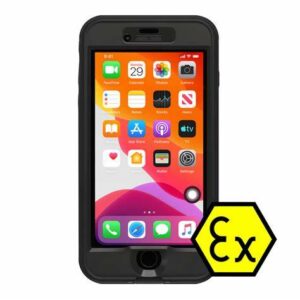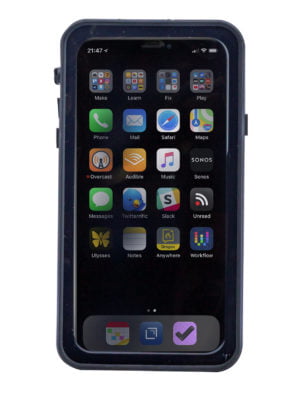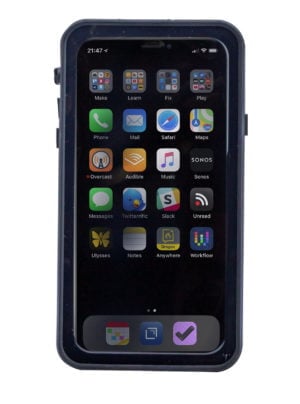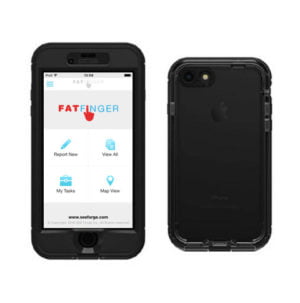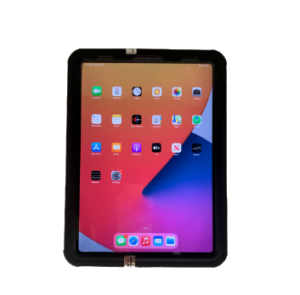Class 1 Division 1 Mobile Device
Showing all 8 resultsSorted by popularity
-

Xciel iPhone 14 ATEX Zone 2
$78000Price Depends on product option Make a selection to update price -
%22%20transform%3D%22translate(.8%20.8)%20scale(1.57813)%22%20fill-opacity%3D%22.5%22%3E%3Cellipse%20rx%3D%221%22%20ry%3D%221%22%20transform%3D%22matrix(-2.06303%20111.80025%20-57.6521%20-1.06384%2093%20122.7)%22%2F%3E%3Cellipse%20fill%3D%22%23fff%22%20cx%3D%22176%22%20cy%3D%22150%22%20rx%3D%2225%22%20ry%3D%22189%22%2F%3E%3Cellipse%20fill%3D%22%23fff%22%20rx%3D%221%22%20ry%3D%221%22%20transform%3D%22matrix(-.65349%20-187.20933%2021.87594%20-.07636%2014.9%20140.2)%22%2F%3E%3Cellipse%20fill%3D%22%23fff%22%20rx%3D%221%22%20ry%3D%221%22%20transform%3D%22matrix(188.99556%20-1.2952%20.13954%2020.36132%20100.6%20246.7)%22%2F%3E%3C%2Fg%3E%3C%2Fsvg%3E)
Xciel iPhone 11 Case ATEX Zone 2
$83700Price Depends on product option Make a selection to update price -
%22%20transform%3D%22translate(.8%20.8)%20scale(1.57813)%22%20fill-opacity%3D%22.5%22%3E%3Cellipse%20rx%3D%221%22%20ry%3D%221%22%20transform%3D%22matrix(-56.32533%20-1.0061%202.00595%20-112.30174%2093.8%20121.3)%22%2F%3E%3Cellipse%20fill%3D%22%23fff%22%20rx%3D%221%22%20ry%3D%221%22%20transform%3D%22matrix(25.09579%20.5695%20-4.2879%20188.9514%20171%20124.6)%22%2F%3E%3Cellipse%20fill%3D%22%23fff%22%20cx%3D%2212%22%20cy%3D%22145%22%20rx%3D%2223%22%20ry%3D%22189%22%2F%3E%3Cellipse%20fill%3D%22%23fff%22%20rx%3D%221%22%20ry%3D%221%22%20transform%3D%22matrix(.635%2016.52939%20-188.86066%207.2553%2088%20245.5)%22%2F%3E%3C%2Fg%3E%3C%2Fsvg%3E)
Xciel iPhone 12 Case
$83700Price Depends on product option Make a selection to update price -
%22%20transform%3D%22translate(.6%20.6)%20scale(1.1836)%22%20fill-opacity%3D%22.5%22%3E%3Cellipse%20rx%3D%221%22%20ry%3D%221%22%20transform%3D%22matrix(49.47382%20-1.5636%202.4442%2077.33643%20179%20128.2)%22%2F%3E%3Cellipse%20fill%3D%22%23fff%22%20cx%3D%22147%22%20cy%3D%22243%22%20rx%3D%22253%22%20ry%3D%2228%22%2F%3E%3Cellipse%20fill%3D%22%23fff%22%20rx%3D%221%22%20ry%3D%221%22%20transform%3D%22rotate(92.3%2078.6%2090.1)%20scale(24.02802%20238.72615)%22%2F%3E%3Cellipse%20fill%3D%22%23f1f1f1%22%20rx%3D%221%22%20ry%3D%221%22%20transform%3D%22matrix(-8.27876%20-56.06363%2087.70796%20-12.95158%209.7%20130.1)%22%2F%3E%3C%2Fg%3E%3C%2Fsvg%3E)
Xciel iPhone 8 Case ATEX Zone 2
$78500Price Depends on product option Make a selection to update price -
%27%20fill-opacity%3D%27.5%27%3E%3Cellipse%20fill%3D%22%23ffe0cc%22%20fill-opacity%3D%22.5%22%20rx%3D%221%22%20ry%3D%221%22%20transform%3D%22matrix(-25.08108%2071.62034%20-54.34406%20-19.03102%2089.7%20223.2)%22%2F%3E%3Cellipse%20fill%3D%22%23002d74%22%20fill-opacity%3D%22.5%22%20rx%3D%221%22%20ry%3D%221%22%20transform%3D%22matrix(-109.6861%20-135.45105%2041.31368%20-33.45516%20136.9%2044.7)%22%2F%3E%3Cellipse%20fill%3D%22%23451936%22%20fill-opacity%3D%22.5%22%20rx%3D%221%22%20ry%3D%221%22%20transform%3D%22matrix(35.55843%2011.73397%20-54.61816%20165.514%2014.9%2096)%22%2F%3E%3Cellipse%20fill%3D%22%23cc5a6a%22%20fill-opacity%3D%22.5%22%20rx%3D%221%22%20ry%3D%221%22%20transform%3D%22matrix(-11.5388%20100.99253%20-29.44792%20-3.36454%2057%20137.3)%22%2F%3E%3C%2Fg%3E%3C%2Fsvg%3E)
Xciel iPhone 13 ATEX Zone 2 Case
$83700Price Depends on product option Make a selection to update price -

Xciel iPad Mini 6 Case ATEX Zone 2
$1,73450Price Depends on product option Make a selection to update price -
%22%20transform%3D%22translate(.8%20.8)%20scale(1.57813)%22%20fill-opacity%3D%22.5%22%3E%3Cellipse%20rx%3D%221%22%20ry%3D%221%22%20transform%3D%22matrix(-2.06303%20111.80025%20-57.6521%20-1.06384%2093%20122.7)%22%2F%3E%3Cellipse%20fill%3D%22%23fff%22%20cx%3D%22176%22%20cy%3D%22150%22%20rx%3D%2225%22%20ry%3D%22189%22%2F%3E%3Cellipse%20fill%3D%22%23fff%22%20rx%3D%221%22%20ry%3D%221%22%20transform%3D%22matrix(-.65349%20-187.20933%2021.87594%20-.07636%2014.9%20140.2)%22%2F%3E%3Cellipse%20fill%3D%22%23fff%22%20rx%3D%221%22%20ry%3D%221%22%20transform%3D%22matrix(188.99556%20-1.2952%20.13954%2020.36132%20100.6%20246.7)%22%2F%3E%3C%2Fg%3E%3C%2Fsvg%3E)
Intrinsically Safe iPhone XR Case ATEX Zone 2
$78500Price Depends on product option Make a selection to update price -

Xciel iPad Mini 7 Case – ATEX Zone 2
$1,68000Price Depends on product option Make a selection to update price
- Intrinsic Safety and Design: Class 1 Division 1 mobile devices are meticulously engineered to prevent internal and external components from causing ignition in environments with flammable substances, ensuring reliable communication and data management in hazardous conditions.
- Durability and Functionality: These devices are crafted to withstand extreme environmental conditions and are equipped with user-friendly features to augment safety and operational efficiency, even for personnel in protective gear.
- Compliance and Benefits: Rigorously tested and certified to meet global safety standards, these devices offer a cost-effective investment for industries where safety is non-negotiable, facilitating higher productivity while safeguarding workers.
Class 1 Division 1 Mobile Device
In the intricate world of hazardous environments, where safety is not just a requirement but a critical necessity, understanding and implementing the right equipment can be the difference between a day’s work and a catastrophic event. Among the plethora of safety devices, the Class 1 Division 1 mobile device stands out as a paramount tool for ensuring seamless and secure communication and operational efficiency in such perilous conditions. At the Intrinsically Safe Store, we pride ourselves on understanding the unique needs of industries operating within these environments – from oil and gas to mining and pharmaceuticals. Our focus on providing certified safe products, including the indispensable Class 1 Division 1 mobile devices, is tailor-made for individuals and organizations committed to upholding the highest safety standards.
Navigating through the technical terrain of these devices, we aim to shed light on their importance, functionality, and why they are essential for safety in hazardous locations. As we delve deeper into the realm of intrinsically safe equipment, let’s explore how these specialized mobile devices not only ensure compliance with international safety standards but also embody our mission to connect people with certified safe solutions, making the world a safer place, one device at a time.
Designing for Extreme Environments
When it comes to operating in hazardous locations, the design of a Class 1 Division 1 mobile device plays a pivotal role in ensuring the safety and reliability of communication and data management. These environments, typically found in industries such as oil and gas, mining, and pharmaceuticals, are characterized by the presence of flammable gases, vapors, or dust, which pose a significant risk of ignition and explosion. Therefore, the intrinsic safety of mobile devices used in such settings cannot be overstated.
The core design philosophy behind a Class 1 Division 1 mobile device centers on preventing the internal and external components from producing any spark or heat that could trigger an ignition. This is achieved through meticulous engineering practices that involve the use of explosion-proof materials, enclosures that can contain and isolate any internal explosion, and stringent control over the operating temperatures of the device.
Moreover, these devices are engineered to withstand extreme conditions beyond the risk of explosions. Given the rugged nature of industries like oil and gas and mining, Class 1 Division 1 mobile devices are also designed to endure extreme temperatures, both high and low, as well as resist water, dust, and shocks. This level of durability ensures that workers in hazardous environments can rely on their devices for communication and data gathering without the risk of failure or safety breaches.
In addition to physical durability, the functionality of these devices is tailored to meet the unique challenges of hazardous environments. This includes long battery life for extended field operations, easy-to-use interfaces for use with protective gloves, and compatibility with other intrinsically safe equipment. By addressing these specific needs, Class 1 Division 1 mobile devices not only augment safety protocols but also enhance operational efficiency.
At the Intrinsically Safe Store, our range of Class 1 Division 1 mobile devices embodies these rigorous design and safety standards. Each product in our portfolio is rigorously tested and compliant with international safety standards, assuring our clients in the oil and gas, mining, and pharmaceutical sectors that they are equipped with the highest level of protection against the inherent risks of their operations. Our mission is to provide equipment that doesn’t just meet the standard but exceeds it, making every minute of operation as safe as possible for the 19 people we help protect every minute.
Key Features of Class 1 Division 1 Devices
Class 1 Division 1 (C1D1) devices are engineered to the highest safety standards for use in hazardous environments where the risk of explosions is significant. These devices are essential for industries like oil and gas, mining, and pharmaceuticals, where the presence of flammable gases or dust can create potentially explosive atmospheres. Understanding the key features of C1D1 mobile devices can help individuals and organizations select the right equipment to ensure safety and compliance in these high-risk areas.
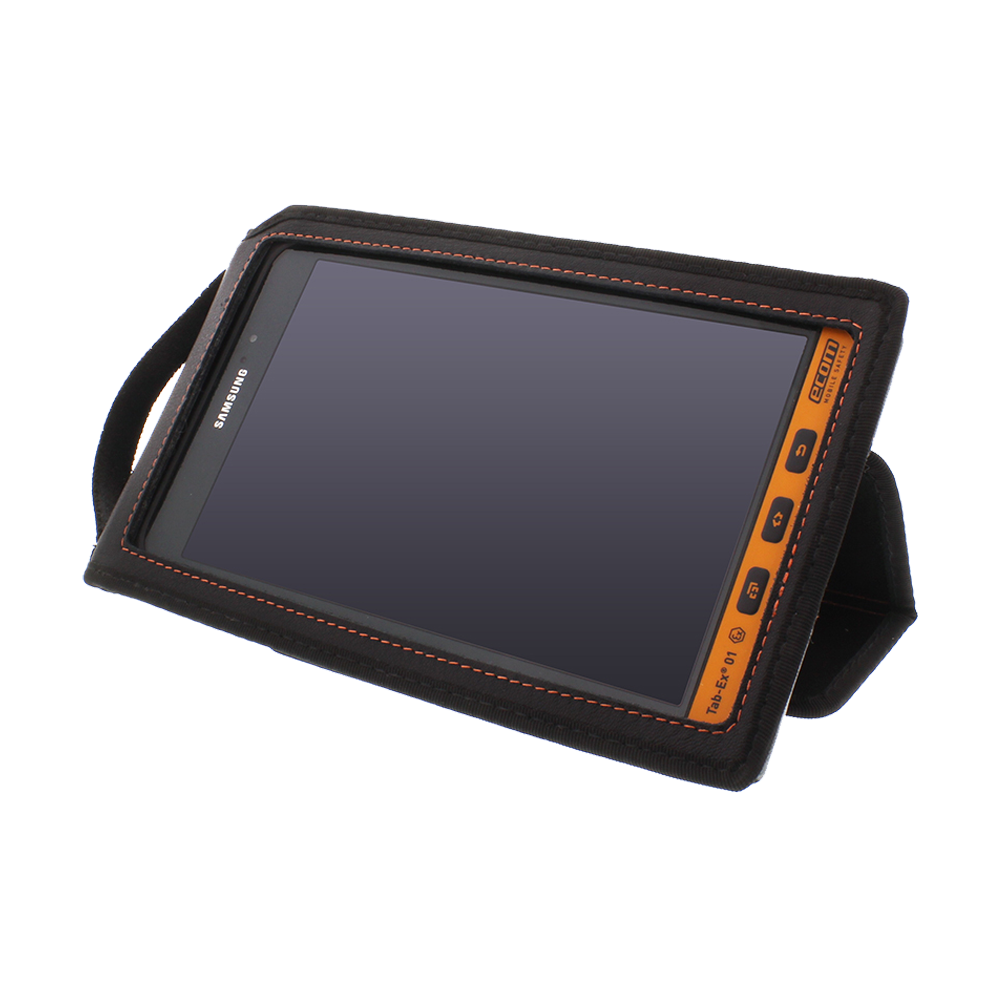
Intrinsic Safety: The most critical feature of Class 1 Division 1 devices is their intrinsic safety. This means that the device itself cannot cause an ignition of the surrounding atmosphere, even under fault conditions. Components are designed in such a way that they limit the electrical and thermal energy available for ignition.
Rugged Design: These devices boast a rugged design that withstands harsh environmental conditions including extreme temperatures, humidity, dust, and shock. Their durability ensures reliable performance even in the most challenging situations, reducing the risk of failure when it matters most.
Advanced Communication Capabilities: Despite their primary focus on safety, C1D1 mobile devices do not compromise on communication. They offer advanced features such as push-to-talk, Wi-Fi connectivity, and long-lasting battery life, ensuring that teams in hazardous areas can stay connected safely and efficiently.
Easy to Use in PPE: Given that personnel in hazardous environments typically wear protective gear, C1D1 devices are designed with user-friendly interfaces. This includes larger buttons and touchscreens that can be operated with gloves, ensuring that safety does not come at the expense of functionality.
Certification and Compliance: Class 1 Division 1 devices are rigorously tested to ensure they meet global safety standards, including ATEX and IECEx. This certification is a testament to their reliability and effectiveness in preventing hazardous accidents.
Customizable for Specific Needs: Recognizing that each hazardous environment has its unique challenges, C1D1 devices offer various customizations to cater to specific operational needs. This may include options for barcode scanning, cameras, or gas detection capabilities, making them versatile tools for safety and productivity.
By providing these key features, Class 1 Division 1 mobile devices play a vital role in enhancing safety in hazardous environments. At the Intrinsically Safe Store, our array of C1D1 certified products embodies our commitment to offering the highest standard of safety technology. These devices are more than just tools; they are lifelines for workers in industries where the margin for error is non-existent.
Safety First: Compliance and Certification
When exploring solutions for hazardous environments, understanding the significance of compliance and certification is paramount. A Class 1 Division 1 mobile device is not merely a label but a guarantee that the equipment can safely operate in the most hazardous conditions where flammable gases, vapors, or liquids are present under normal operating circumstances.
These devices adhere strictly to safety standards set by authoritative bodies such as ATEX in Europe, IECEx internationally, and NEC 500 in the United States. The classification of ‘Class 1 Division 1’ specifies that the device is suitable for environments where explosive atmospheres are expected to exist as part of regular operations. Achieving this level of certification necessitates rigorous testing to prove that the device can prevent any internal or external spark or heat source from igniting a volatile atmosphere.
At the Intrinsically Safe Store, every Class 1 Division 1 mobile device in our range has undergone extensive scrutiny and testing. This ensures they meet or exceed the strict standards set forth by these regulatory agencies. Our certification process involves not only testing for electrical and thermal risks but also evaluating physical toughness to withstand the harsh conditions often found in oil and gas, mining, and pharmaceutical environments.
The importance of choosing certified equipment cannot be overstressed. It’s about more than compliance; it’s about ensuring the safety and well-being of employees and protecting valuable assets. By selecting a Class 1 Division 1 certified mobile device from our selection, you choose a product designed with safety at its core. This commitment to safety is in line with our mission to connect people with certified safe solutions, aiming to make industrial environments safer, one device at a time.
Remember, in hazardous areas, the cost of non-compliance can be far greater than the expense of investing in properly certified equipment. Ensuring the safety of your operations and your team starts with choosing the right class of device for your needs.
Real-World Applications and User Cases
Class 1 Division 1 mobile devices play a critical role in ensuring safe and efficient operations across a multitude of sectors dealing with hazardous environments. These devices are designed to not only withstand but also prevent any ignition of flammable gases, vapors, or dust, which are prevalent in these sectors. Let’s delve into some real-world applications and user cases of these indispensable devices.
In the Oil and Gas Industry
The oil and gas sector, known for its hazardous locations, relies heavily on Class 1 Division 1 mobile devices for safe communication and data management. Field engineers and technicians use these devices to monitor operations, control processes, and communicate in real-time, ensuring any potential safety issues can be addressed immediately. These devices allow for the seamless capture and transmission of data, even in extreme conditions, supporting predictive maintenance and operational efficiency.
At Chemical Manufacturing Plants
Chemical manufacturing plants are environments where the risk of explosions is significantly high due to the presence of flammable substances. Here, Class 1 Division 1 mobile devices are essential for workers who need to collect data, manage inventory, and perform routine checks without the risk of igniting hazardous materials. The robustness and reliability of these devices ensure operations continue smoothly while prioritizing worker safety.
Within the Mining Sector
 Mining is another industry that benefits greatly from the use of Class 1 Division 1 mobile devices. Deep underground, where traditional communication devices fail or pose significant risks, these intrinsically safe devices provide a lifeline, enabling miners to communicate and navigate safely. They are crucial for coordinating tasks, tracking personnel, and enhancing safety protocols in these dark, confined, and potentially explosive environments.
Mining is another industry that benefits greatly from the use of Class 1 Division 1 mobile devices. Deep underground, where traditional communication devices fail or pose significant risks, these intrinsically safe devices provide a lifeline, enabling miners to communicate and navigate safely. They are crucial for coordinating tasks, tracking personnel, and enhancing safety protocols in these dark, confined, and potentially explosive environments.
In Pharmaceutical Manufacturing
Pharmaceutical manufacturing involves the handling of various chemicals and substances that could be explosive under certain conditions. Class 1 Division 1 mobile devices are used by technicians to safely document processes, manage quality control, and maintain communication within these cleanroom environments. The ability to safely capture and share data in real-time is pivotal for compliance and ensuring the highest standards of product safety and quality.
Emergency Response Teams
For emergency response teams working in or around hazardous environments, Class 1 Division 1 mobile devices are not just tools but lifelines. Whether it’s responding to a chemical spill, a fire in an industrial facility, or a natural disaster impacting infrastructure, these devices ensure seamless and safe communication. They enable teams to coordinate effectively, assess situations accurately, and carry out their duties without compromising their safety or the safety of others.
By incorporating Class 1 Division 1 mobile devices into their operations, organizations across these diverse sectors are not only adhering to strict safety standards but are also enhancing operational efficiency, productivity, and communication. At the Intrinsically Safe Store, we pride ourselves on knowing that our wide array of certified safe products, including these indispensable mobile devices, play a vital part in maintaining safety and efficiency in such critical industries.
Comparing Class 1 Division 1 Devices to Non-Rugged Alternatives
In the realm of mobile devices designed for hazardous environments, Class 1 Division 1 (Class 1 Div 1) devices stand out for their rigorous safety standards and robustness, offering stark contrasts to non-rugged alternatives commonly found in less demanding settings. Understanding the key differences between these two categories of devices is essential for individuals and organizations operating in industries such as oil and gas, mining, and pharmaceuticals, where the risk of explosive atmospheres is a constant concern.
Safety Certification and Design: The most critical difference lies in the safety certifications and design philosophies. Class 1 Div 1 devices are engineered to operate safely in environments where explosive gases, vapors, or dusts are present continuously or for extended periods. They are built from the ground up with intrinsic safety in mind, meaning they limit electrical and thermal energy to a level below that which can ignite a specific hazardous atmospheric mixture. Non-rugged devices, however, lack such certifications and are not designed to mitigate these risks, making them unsuitable and dangerous for use in these settings.
Durability and Reliability: Beyond safety, durability is another significant factor. Class 1 Div 1 devices are constructed to withstand extreme conditions, including drops, vibrations, and exposure to water and dust, ensuring they continue to operate reliably in the most challenging environments. In contrast, non-rugged devices are generally more susceptible to physical damage and environmental conditions, which can lead to failure at critical moments, potentially compromising safety and productivity.
Cost of Ownership: The initial investment in a Class 1 Div 1 mobile device is typically higher than that of a non-rugged alternative. However, when considering the total cost of ownership, including potential downtime, loss of productivity, and replacement costs associated with using non-certified devices in hazardous areas, Class 1 Div 1 devices often prove to be more cost-effective in the long run.
Performance and Functionality: While non-rugged devices may offer a wider range of consumer-oriented features and a more familiar user experience, Class 1 Div 1 devices are specifically tailored for the demands of hazardous environments, balancing performance with safety. They provide essential functionalities required for communication, data capture, and monitoring in such settings, ensuring that safety does not come at the expense of performance.
In summary, when comparing Class 1 Division 1 mobile devices to non-rugged alternatives, it is clear that the former provides a level of safety, durability, and reliability that is critical for hazardous environments. While the up-front cost may be higher, the long-term benefits of using devices designed to withstand the rigors of such settings cannot be overstated. For industries committed to maintaining the highest safety standards, investing in Class 1 Div 1 certified devices is not just a choice but a necessity.
FAQs for Class 1 Division 1 Mobile Devices
What industries commonly use Class 1 Division 1 mobile devices?
Class 1 Division 1 (C1D1) mobile devices are essential in industries where explosive gases, vapors, or dusts are present. Notably, they are widely used in the oil and gas industry, chemical manufacturing, pharmaceuticals, grain processing, and mining. These sectors demand the highest level of safety due to the inherent risks involved in their operations. C1D1 devices offer the robust protection needed to prevent accidents caused by electrical and thermal energies.
What are the most popular Class 1 Division 1 mobile devices on the market?
The most popular C1D1 mobile devices include smartphones, tablets, and handheld computers designed with safety and durability in mind. These devices are manufactured by leading companies specializing in intrinsically safe equipment. Popular models often feature rugged builds, advanced communication capabilities, and functionalities tailored to meet the stringent requirements of hazardous work environments. Due to our commitment to customer confidentiality and the ever-evolving market, we encourage you to contact us directly for the latest and most preferred models tailored to your specific industry needs.
What operating systems run on Class 1 Division 1 mobile devices?
C1D1 mobile devices are versatile and can run on various operating systems depending on the manufacturer’s design and the device’s intended use. The most common operating systems include Android and Windows, chosen for their wide application support, reliability, and ease of integration into corporate IT environments. This versatility ensures that users in hazardous industries do not have to compromise on functionality and can leverage the latest software and applications to enhance their operational efficiency.
Can Class 1 Division 1 mobile devices connect to Wi-Fi and cellular networks?
Yes, C1D1 mobile devices are designed to connect to both Wi-Fi and cellular networks, ensuring seamless communication and data exchange in hazardous environments. These connections are carefully engineered to maintain safety standards while offering reliable access to networks for communication, data transfer, and remote monitoring. Connectivity capabilities allow users to stay connected with their teams, access critical information, and respond rapidly to any situation without compromising their safety.
How long can the batteries in Class 1 Division 1 mobile devices last?
The battery life of C1D1 mobile devices varies significantly depending on the device model, usage patterns, and the specific applications in use. Manufacturers design these devices with battery efficiency in mind, offering extended battery life to ensure reliability through long shifts in hazardous environments. Many devices are equipped with batteries that can last for an entire shift or more, with some offering swappable batteries to minimize downtime. For specific battery life details, it’s best to consult the product specifications or contact our team for advice on selecting a device that meets your operational requirements.


























